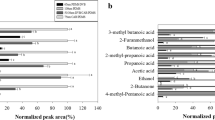Abstract
This work reports on a simple method for the determination of lysine content by an in situ sample pretreatment and headspace gas chromatographic measurement (HS-GC) technique, based on carbon dioxide (CO2) formation from the pretreatment reaction (between lysine and ninhydrin solution) in a closed vial. It was observed that complete lysine conversion to CO2 could be achieved within 60 min at 60 °C in a phosphate buffer medium (pH = 4.0), with a minimum molar ratio of ninhydrin/lysine of 16. The results showed that the method had a good precision (RSD < 5.23%) and accuracy (within 6.80%), compared to the results measured by a reference method (ninhydrin spectroscopic method). Due to the feature of in situ sample pretreatment and headspace measurement, the present method becomes very simple and particularly suitable to be used for batch sample analysis in lysine-related research and applications.

The flow path of the reaction and HS-GC measurement for the lysine analysis





Similar content being viewed by others
References
Tomé D, Bos C. Lysine requirement through the human life cycle. J Nutr. 2007;137:1642S–5S.
Benevenga NJ, Blemings KP. Unique aspects of lysine nutrition and metabolism. J Nutr. 2007;137:1610S–45S.
Smriga M, Ghosh S, Mouneimne Y, Pellett PL, Scrimshaw NS. Lysine fortification reduces anxiety and lessens stress in family members in economically weak communities in Northwest Syria. Proc Natl Acad Sci U S A. 2004;101:8285–8.
Kumari S, Chauhan GS. New cellulose-lysine Schiff-base-based sensor-adsorbent for mercury ions. ACS Appl Mater Interfaces. 2014;6:5908–17.
Huang T, Minghung Chen A, Ho CT. Effect of phosphate on stability of pyridoxal in the presence of lysine. J Agric Food Chem. 2001;49:1559–63.
Chen L, Yang L, Li H, Gao Y, Deng D, Wu Y, et al. Tridentate lysine-based fluorescent sensor for Hg(II) in aqueous solution. Inorg Chem. 2011;50:10028–32.
Moughan PJ. Amino acid availability: aspects of chemical analysis and bioassay methodology. Nutr Res Rev. 2003;16:127–41.
Slyke DDV, Macfadyen DA, Hamilton P. Determination of free amino acids by titration of the carbon dioxide formed in the reaction with ninhydrin. J Biol Chem. 1941;141:671–80.
Lee YP, Takahashi T, Lee YP. An improved colorimetric determination of amino acids with the use of ninhydrin. Anal Biochem. 1966;14:71–7.
Fitzpatrick WH. Spectrophotometric determination of amino acids by the ninhydrin reaction. J Science. 1949;109:469–9.
Friedman M. Applications of the ninhydrin reaction for analysis of amino acids, peptides, and proteins to agricultural and biomedical sciences. J Agric Food Chem. 2004;52:385–406.
Mitic SS, Miletic GZ, Petrovic AN, Tosic SB. A kinetic determination of lysine in pharmaceutical sample. J Serb Chem Soc. 2002;67:783–92.
Steed R. Title of subordinate document. In: Analysis of amino acids by HPLC. https://www.agilent.com/cs/library/slidepresentation/Public/Amino%20Acid%20Analysis_062410_Rita%20Steed.pdf. Accessed 3 Oct 2017.
Hurrell RF, Lerman P, Carpenter KJ. Reactive lysine in foodstuffs as measured by a rapid dye-binding procedure. J Food Sci. 1979;44:1221–7.
Maga JA. Measurement of available lysine using the guanidination reaction. J Food Sci. 1981;46:132–4.
Major EJ, Batterham ES. Availability of lysine in protein concentrates as determined by the slope-ratio assay with chicks and comparisons with rat, pig and chemical assays. Br J Nutr. 1981;46:513–9.
Moehn S, Bertolo RF, Pencharz PB, Ball RO. Development of the indicator amino acid oxidation technique to determine the availability of amino acids from dietary protein in pigs. J Nutr. 2005;135:2866–70.
Rutherford SM, Moughan PJ. Development of a novel bioassay for determining the available lysine contents of foods and feedstuffs. Nutr Res Rev. 2007;20:3–16.
Rutherfurd SM, Moughan PJ. Guanidination of lysine in selected dietary proteins. J Agric Food Chem. 1990;38:209–11.
Kolb B, Ettre LS. Static headspace-gas chromatography: theory and practice, 2nd Edition[J]. Proteomics, 2006.
Chai XS, Luo Q, Zhu JY. Analysis of nonvolatile species in a complex matrix by headspace gas chromatography. J Chromatogr A. 2001;909:249–57.
Xiang XD, Wan XF, Li YM, Wu SB. Neutral TEMPO oxidation of bamboo cellulose fiber under microwave radiation and its characterization. Chem Ind Forest Prod. 2015;35:101–6.
Dash R, Elder T, Ragauskas AJ. Grafting of model primary amine compounds to cellulose nanowhiskers through periodate oxidation. Cellulose. 2012;19:2069–79.
Siller M, Amer H, Bacher M, Roggenstein W, Rosenau T, Potthast A. Effects of periodate oxidation on cellulose polymorphs. Cellulose. 2015;22:2245–61.
Xie WQ, Chai XS. Determination of epoxy groups in epoxy resins by reaction-based headspace gas chromatography. Polym Test. 2017;59:113–7.
Harding VJ, Warneford FHS. The ninhydrin reaction with amino-acids and ammonium salts. J Biol Chem. 1916;25:319–35.
Varlet V, Smith F, De FS, Dominguez A, Rinaldi A, Augsburger M, et al. Innovative method for carbon dioxide determination in human postmortem cardiac gas samples using headspace-gas chromatography-mass spectrometry and stable labeled isotope as internal standard. Anal Chim Acta. 2013;784:42–6.
D'Aniello A, D'Onofrio G, Pischetola M, Strazzullo L. Effect of various substances on the colorimetric amino acid-ninhydrin reaction. Anal Biochem. 1985;144:610–1.
Kabir-ud-Din, Salem JKJ, Kumar S, Khan Z. Micellar and salt effects on the Ruhemann’s purple formation between L-lysine and ninhydrin. Indian J Chem. 2000;39:1019–23.
Kolakovic R, Laaksonen T, Peltonen L, Laukkanen A, Hirvonen J. Spray-dried nanofibrillar cellulose microparticles for sustained drug release. Int J Pharm. 2012;430:47–55.
Bhandari J, Mishra H, Mishra PK, Wimmer RW, Ahmad FJ, Talegaonkar S. Cellulose nanofiber aerogel as a promising biomaterial for customized oral drug delivery. Int J Nanomedicine. 2017;12:2021–31.
Choi DH, Lee K. Effects of ionic speciation of lysine on its adsorption and desorption through a sulfone-type ion-exchange column. J Microbiol Biotechnol. 2007;17:1527–32.
Funding
The authors acknowledge the financial support from the National Major Research Project (Project No. 2017YFB0307900). This work is also partly supported by Science and Technology Planning Project of Guangdong Province (Project No. 2017B090901064).
Author information
Authors and Affiliations
Corresponding author
Ethics declarations
Conflict of interest
The authors declare that they have no conflicts of interest.
Electronic supplementary material
ESM 1
(PDF 171 kb)
Rights and permissions
About this article
Cite this article
Wan, Xf., Liu, Bl., Yu, T. et al. Determination of lysine content based on an in situ pretreatment and headspace gas chromatographic measurement technique. Anal Bioanal Chem 410, 3111–3117 (2018). https://doi.org/10.1007/s00216-018-0998-6
Received:
Revised:
Accepted:
Published:
Issue Date:
DOI: https://doi.org/10.1007/s00216-018-0998-6




